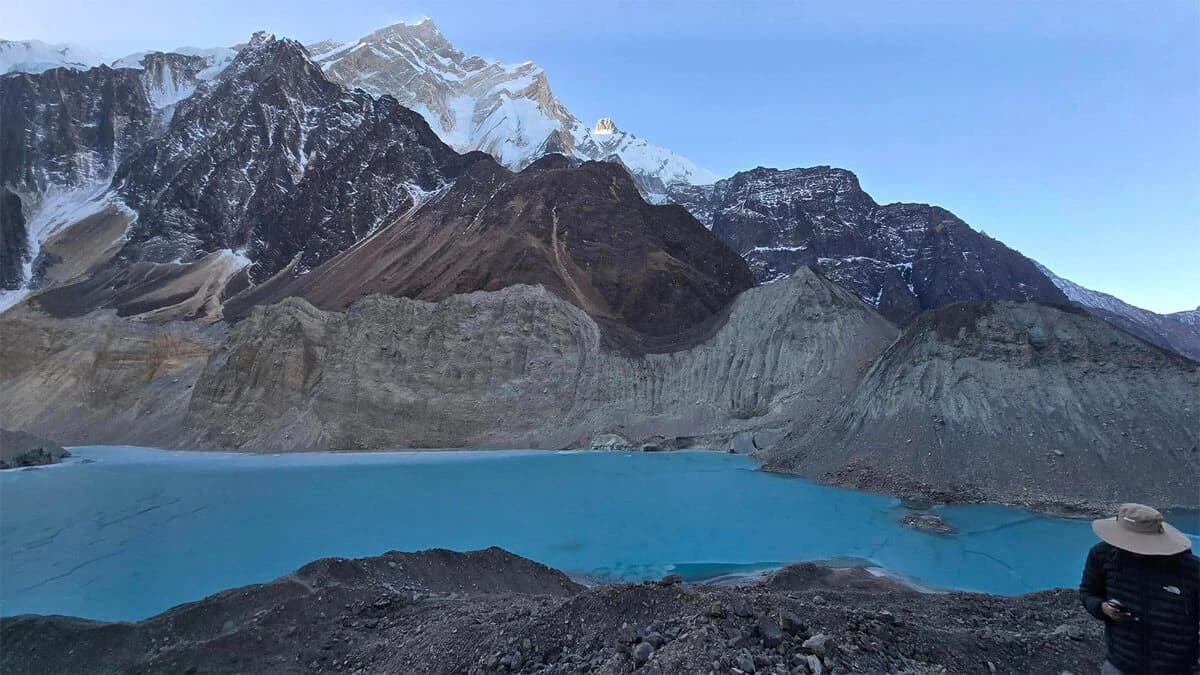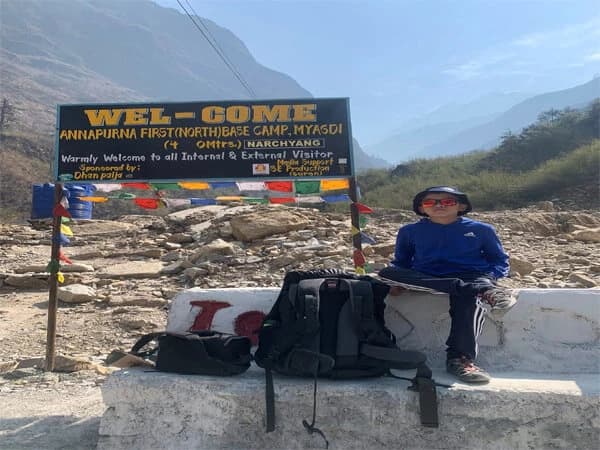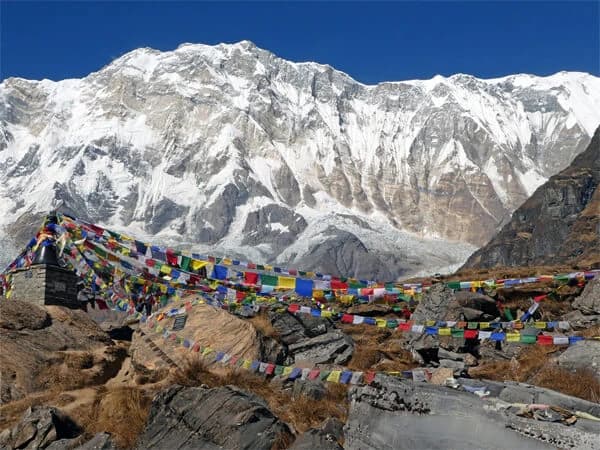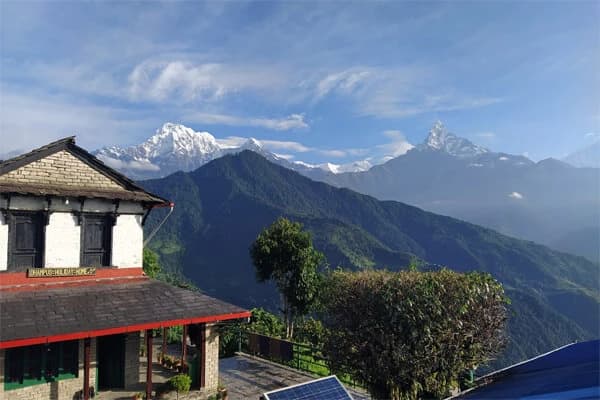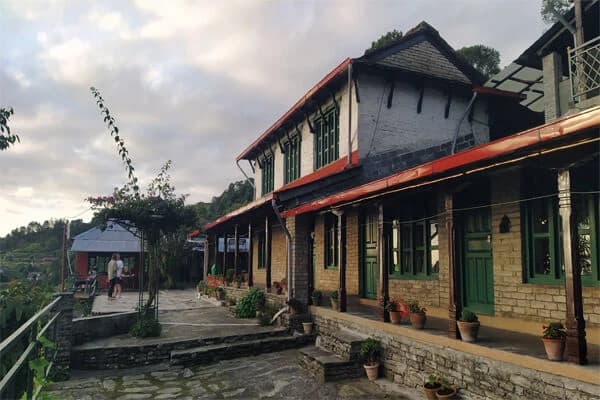The Annapurna Base Camp (ABC) trek is one of Nepal's most well-known trekking routes, and most people have heard of it. However, the majority of tourists are unaware that there is an alternate route to the foot of the magnificient Annapurna range. The North Annapurna Base Camp trek is a hidden treasure for those seeking a quiet, wild, and daring experience.
The North trekking route takes a more isolated path up the northern side of the Annapurna range than the traditional ABC trip, which passes through well-known settlements like Ghandruk and Chhomrong. Deep river gorges, rocky glacier fields, and serene alpine meadows that are rarely seen by visitors are all part of this trek.
This lesser-known route is for you if you have ever wanted to see Annapurna I up close without the crowd. It is more than just a trek. It is a genuine Himalayan trek that gets you closer to unspoiled environment and genuine mountain culture.
The North Annapurna Base Camp Trek: What Is It?
The North Annapurna Base Camp (North ABC) trek is an alternate trekking path that approaches the Annapurna range from the north side. Compared to the well-travelled south path, it provides a whole different experience. The North ABC trek explores a harsh and challenging region, including glaciers, steep moraines, lonely valleys, and high-altitude camping areas, whereas the typical ABC journey passes through green forests, terraced fields, and bustling tea houses.
The trek often starts in a village close to Lete or Tatopani, which are situated along the Kali Gandaki Valley, one of the world's deepest canyons. Following the Hum Khola (Hum River) upstream, the path then travels northeast through the Narchyang Valley. With breathtaking vistas of Annapurna I (8,091 meters), Tilicho Peak, and Nilgiri North, the trail gradually ascends into alpine terrain.
Trekkers need to be prepared for basic conditions because this area is less developed. After a while, there aren't many or any teahouses, so you might have to camp and pack your own food and supplies, particularly in the higher areas. The payoff, however, is substantial: serene paths, breathtaking vistas, and the impression that you are genuinely off the beaten path.
Why choose the North Path?
Trekkers are beginning to discover and adore the North Annapurna Base Camp route for a variety of reasons. Here are a few of the most significant ones:
- Less Crowds: During the spring and fall seasons, the traditional Annapurna Base Camp path can get very crowded. The North trail, however, is serene and calm. You may not see another trekker for the whole day.
- More Adventure: Those who like a little difficulty would love this trek. It feels more like a real expedition because the trail is unmarked and wild. It is a fantastic option for seasoned trekkers seeking something different.
- Beautiful Scenery: The North route offers a strong and real perspective of the Himalayas, with deep river valleys and enormous glaciers. From this angle, Annapurna I appears closer and more dramatic.
- Local Culture: There is a strong Tibetan influence in the settlements along the trail. Locals are friendly and hospitable, and many of them continue to lead traditional lives. It is a fantastic opportunity to get a more authentic taste of Nepali mountain culture.
- Untouched Nature: This route is cleaner and more natural because fewer people travel it. You will have a stronger sense of connection to the nature and have a better chance of seeing wildlife.
North Annapurna Base Camp Trek Itinerary
This is a basic outline of the typical itinerary for the trek to North Annapurna Base Camp. The following provides you a general sense of the itinerary, which may change based on road access, group pace, and weather:
- Day 1: Arrival in Kathmandu
- Day 2: Travel to Pokhara
- Day 3: Take a bus or jeep from Pokhara to Tatopani to Humkhola. Spend the night at a nearby resort.
- Day 4: Trek from Hum Khola to Busket Mela.
- Day 5: Trek from Busket Mela to Campsite. Proceed into the alpine zone via a difficult trail. Start to see snowfields and glaciers.
- Day 6: Trek to the 4,100-meter-high North Annapurna Base Camp. Trek back to lower elevations.
- Day 7: Drive to Pokhara after trekking back down the valley to Lete or Tatopani.
The entire duration of the trek might range from 7-8 days, depending on your pace and the route variations.
Trekking conditions and Physical Demands
The trek to North Annapurna Base Camp is not a simple one. It is a little harder than the well-known South ABC journey. This is due to the fact that it passes through a more isolated and wild portion of the Annapurna. There are fewer people along the route, and it is not well-maintained. Unlike other well-traveled trekking routes, you won't find tea houseses or tiny businesses, especially as you ascend higher in elevation.
In certain areas, the routes may be rough, steep, and slippery. You may have to trek over avalanche zones, cross rivers, or walk on glaciers in some places. Therefore, those who are physically fit and have some trekking experience are better suited for the trek. You should feel at ease trekking 5-7 hours a day with a backpack, but you don't have to be an expert in the mountains. It will be quite beneficial to train in advance by walking, trekking, and strengthening your legs.
Being mentally prepared is also important. You won't have access to amenities like internet, hot baths, or cozy mattresses. In exchange you will receive tranquillity, breathtaking Himalayan scenery, and a memorable experience.
Expenses & Transportation
Planning is essential because this trek is off the beaten path. You need camping equipment, extra staff assistance, and an experienced guide. Therefore, the North Annapurna Base Camp trek is more expensive than some other treks. You have to start with the majority of your supplies because there aren't as many places to buy them along the way. Here is a general estimate of the expenses:
- North Annapurna Base Camp trek Permits: A TIMS card (Trekkers’ Information Management System) costs about $20, and the Annapurna Conservation Area Permit (ACAP) costs about $30. These are typical for the majority of Annapurna treks.
- North Annapurna Base Camp trek Porter and Guide: It will cost between $25 and $35 a day to hire a guide. The cost of a porter is between $15 to $25 each day. To make the stroll more enjoyable, have a porter carry your bulky backpack.
- North Annapurna Base Camp trek Camping Supplies: Tents, sleeping bags, cooking equipment, and food are required because the base camp is not close to any tea houses. You may rent these in Kathmandu or Pokhara if you don't already have them.
- Nepal Trekking Package: Nepal Trekking Routes, a local trekking agency offers a complete package, including permits, a guide, a porter, food, and equipment, for a single cost. Depending on the size of the group and the level of comfort, the Package costs $700 to $1,500.
When the weather is clear and dry, the best seasons for Nepal Trekking are spring (March–May) and fall (September–November). Steer clear of winter (December–February) due to snow and bitter cold, and monsoon (June–August) due to rain and landslides.
Safety and Preparation
Safety is very important on this trek. Since the North Annapurna Trekking trail is more isolated, you won’t see many other trekkers or villages in case something goes wrong. That is why going with an experienced guide is strongly recommended. They know the trail, can help you cross tricky areas, and know what to do in emergencies.
You will also be trekking at high altitudes over 4,000 meters so you need to be aware of altitude sickness. Walk slowly, drink lots of water, and listen to your body. If you feel dizzy, very tired, or have a headache, tell your guide right away.
Always keep layers of warm clothing, a first aid kit, and water purification pills on hand. The highlands can see dramatic drops in temperature. Additionally, as most of the trail is without electricity, pack a power bank or solar charger.
Lastly, be sure to purchase travel insurance that includes helicopter rescue and high-altitude trekking coverage. This is crucial in case you become ill or are hurt and require immediate medical attention. Being safe is better than being sorry.
Respect for the Environment and Culture
In addition to offering breathtaking vistas, trekking in the Annapurna region teaches respect for the local population and the earth. The North ABC trail passes through isolated communities where residents lead simple lives among the natural world. Farmers, yak herders, and Buddhist monks may be encountered. Be courteous and kind at all times. It makes a big difference to smile, say "namaste," and ask before snapping pictures.
Try to follow the Leave No Trace guidelines as well. Avoid leaving trash on the route. Take your trash with you until you locate a suitable location to get rid of it. Use reusable water bottles instead of plastic ones, and purify your water.
By hiring a local porter or guide, you are contributing to the local economy in these mountain towns. In areas where tourism is the primary source of revenue, this has a significant impact.
Conclusion: Trekking Off the Beaten Path, Discovering North Annapurna Base Camp
The unique quality of the North Annapurna Base Camp trek is that it is not for everyone. You will travel through unspoiled areas, serene valleys, and breathtaking mountain vistas that not many people ever get to see. It is an adventure for the interested, the daring, and those who seek for a closer relationship with nature.
Nepal Trekking Routes will make your trek safer, easier, and more fulfilling. Their knowledgeable locals, skilled guides, and personal attention let you concentrate on what really counts. You will enjoy the beauty of the journey and the delight of exploring the hidden gem of Himalayas

